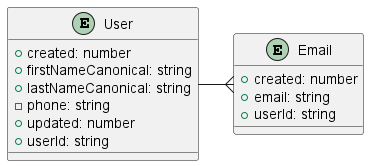What Good Looks Like: A Real-World Typescript Refactor

Yesterday I posted a bit of a screed about iteration and the use of abstraction & generic design.
I left the ending a little ragged, as the act of writing it had focused my thoughts and opened up an avenue of approach to a solution. Which was really the point of writing the thing in the first place.
In the last 24 hours, the solution has crystallized into a radical new configuration. I’d like to share this with you, because this is really the living example of all the theory I was spouting yesterday.
Don’t be afraid to read this! It won’t be that long, and I’ll keep it accessible to non-developers.
A Scenario
As I discussed in detail yesterday, I’m working on a Typescript refactor of my entity-manager library. This widget is intended to take most of the pain out of operating at scale with DynamoDB and other NoSQL databases in the presence of a rich data model.
To accomplish this, entity-manager takes a (relatively) simple configuration object as input and uses it to do all kinds of fiddly things to get the database to behave.
A picture is worth a thousand words, so let’s take as our example a back-end service that manages users and their email addresses. This diagram represents those two entities and the relationship between them, along with some critical properties:

Here’s what I need from this service:
-
One User can have many Emails.
-
I can get a User record by
userIdand search for Users bycreated,firstNameCanonical,lastNameCanonical,phone&updated. -
I can get an Email record by
emailand search for emails bycreated&userId.
Moreover, since this service is currently in production, so far as the database is concerned the refactor must exactly mimic existing behavior.
Baseline State
The entity-manager configuration object is everything, since the whole point of the library is to hide everything else from the developer.
So if using entity-manager is easy, it’s because the config object is simple and straightforward. And if it’s hard, it’s because the config object is complex and a pain in the butt to manage.
Here’s the config object for the actual production service described above. Don’t sweat the code if you aren’t a developer! I’m just showing it to you for a sense of scale.
const entityConfig = {
entities: {
email: {
defaultLimit: 10,
defaultPageSize: 10,
indexes: {
userId: ["entityPK", "entitySK", "userId"],
},
keys: {
entityPK: {
encode: ({ entityToken = "email", shardId }) =>
`${entityToken}!${sn2e`${shardId}`}`,
decode: (value) =>
value.match(/^(?<entityToken>.*)!(?<shardId>.*)$/)
?.groups,
},
entitySK: {
encode: ({ email }) => sn2u`email#${email}`,
decode: (value) =>
value.match(/^email#(?<email>.*)$/)?.groups,
},
userId: {
encode: ({ userId }) => userId,
decode: (value) => ({ userId: value }),
retain: true,
},
},
sharding: {
entityKey: ({ email }) => email,
timestamp: ({ created }) => created,
},
},
user: {
defaultLimit: 10,
defaultPageSize: 10,
indexes: {
created: ["entityPK", "entitySK", "created"],
firstName: ["entityPK", "entitySK", "firstNameSK"],
lastName: ["entityPK", "entitySK", "lastNameSK"],
phone: ["entityPK", "entitySK", "phone"],
updated: ["entityPK", "entitySK", "updated"],
},
keys: {
entityPK: {
encode: ({ entityToken = "user", shardId }) =>
`${entityToken}!${sn2e`${shardId}`}`,
decode: (value) =>
value.match(/^(?<entityToken>.*)!(?<shardId>.*)$/)
?.groups,
},
entitySK: {
encode: ({ userId }) => sn2u`userId#${userId}`,
decode: (value) =>
value.match(/^userId#(?<userId>.*)$/)?.groups,
},
created: {
encode: ({ created }) => Number(created),
decode: (value) => ({ created: value.toString() }),
retain: true,
},
firstNameSK: {
encode: ({ firstNameCanonical, lastNameCanonical }) =>
sn2u`firstNameCanonical#${firstNameCanonical}${sn2e`|lastNameCanonical#${lastNameCanonical}`}`,
decode: (value) =>
value.match(
/^firstNameCanonical#(?<firstNameCanonical>.*?)(?:\|lastNameCanonical#(?<lastNameCanonical>.*))?$/
)?.groups,
},
lastNameSK: {
encode: ({ lastNameCanonical, firstNameCanonical }) =>
sn2u`lastNameCanonical#${lastNameCanonical}${sn2e`|firstNameCanonical#${firstNameCanonical}`}`,
decode: (value) =>
value.match(
/^lastNameCanonical#(?<lastNameCanonical>.*?)(?:\|firstNameCanonical#(?<firstNameCanonical>.*))?$/
)?.groups,
},
phone: {
encode: ({ phone }) => phone,
decode: (value) => ({ phone: value }),
retain: true,
},
updated: {
encode: ({ updated }) => Number(updated),
decode: (value) => ({ updated: value.toString() }),
retain: true,
},
},
sharding: {
entityKey: ({ userId }) => userId,
timestamp: ({ created }) => created,
},
},
},
shardKeyToken: "shardId",
};
Couple of points worth noting here…
-
This thing is pretty big and complex! To represent the two related entities & indexing requirements described above, it needed just exactly 100 lines of code.
-
This is Javascript, not Typescript! This complex config object has to be exactly right, and without the type safety Typescript provides, the developer is on his own to discover & fix any config errors. I should know: I designed this thing and I screw it up regularly. 🙄
-
There’s a lot of logic here! But if you examine all those
encodeanddecodefunctions, even across services, they all seem to operate the same way. That’s an opportunity for abstraction.
The New Approach
Remember, this is a Typescript refactor. That means we’re going to bring typing info into the mix alongside the actual configuration object.
Here are the types that a developer would define to drive the new User service config object:
interface User {
created: number;
firstNameCanonical: string;
firstNameRK: never;
lastNameCanonical: string;
lastNameRK: never;
phone: string;
updated: number;
userId: string;
}
interface Email {
created: number;
email: string;
userId: string;
}
interface EntityMap {
user: User;
email: Email;
}
The User & Email interfaces describe the entities themselves, in a way that is useful to drive entity-manager and also wherever else those entities show up in the code. Note that we’ve used the special never type to indicate properties the developer should not populate directly because entity-manager is going to generate them for us.
EntityMap tells entity-manager which parts of the configuration object will be associated with which entities.
Here’s the actual config object:
export const config: Config<EntityMap, "entityPK", "entitySK"> = {
entities: {
user: {
indexes: {
created: ["entityPK", "entitySK", "created"],
firstName: ["entityPK", "entitySK", "firstNameRK"],
lastName: ["entityPK", "entitySK", "lastNameRK"],
phone: ["entityPK", "entitySK", "phone"],
updated: ["entityPK", "entitySK", "updated"],
},
generated: {
firstNameRK: {
elements: ["firstNameCanonical", "lastNameCanonical"],
},
lastNameRK: {
elements: ["lastNameCanonical", "firstNameCanonical"],
},
},
timestampProperty: "created",
uniqueProperty: "userId",
},
email: {
indexes: {
userId: ["entityPK", "entitySK", "userId"],
},
timestampProperty: "created",
uniqueProperty: "email",
},
},
hashKey: "entityPK",
uniqueKey: "entitySK",
};
If you’re counting, that’s just 32 lines… a two-thirds reduction in size! And there is no persnickety functional logic, because all that stuff will now be generated by entity-manager based on the content of the config object.
Moreover, thanks to type safety, it’s almost impossible to screw this up!
Typescript will alert the developer immediately if he…
-
Fails to add an entity specified in the
EntityMapinterface, or adds an entity not specified there. -
Specifies an entity index component that doesn’t exist on the relevant entity with either a
number,string, ornevertype. -
Specifies a generated property that doesn’t exist on the relevant entity with a
nevertype. -
Specifies a generated property component that doesn’t exist on the relevant entity without a
nevertype. -
Specifies an entity
timestampPropertythat doesn’t exist on the relevant entity or doesn’t have anumbertype. -
Specifies an entity
uniquePropertythat doesn’t exist on the relevant entity or doesn’t have anumberorstringtype. -
Fails to specify exactly the right
hashKeyanduniqueKeyproperties. -
Manually populates a value on a
UserorEmailentity anywhere else in his code thatentity-manageris supposed to generate for us.
This, my friends, is what good looks like.
Next Steps
There’s still a lot of work to be done!
My last iteration of entity-manager was type-safe but assumed it was going to receive something very similar to the old config object. The job now is to add the logic that will generate the missing bits from the new config according to the rules I’ve discovered over two years of operating with the Javascript version of the library.
That said: the path forward from here is very clear.
Stay tuned!








Leave a comment